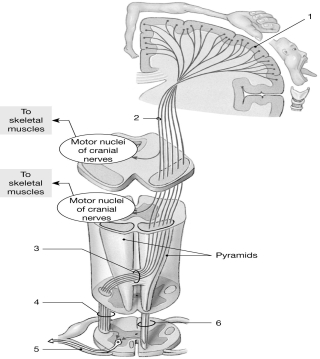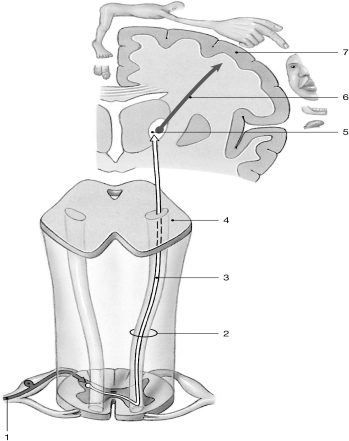A) abducens.
B) facial.
C) vagus.
D) trigeminal.
E) glossopharyngeal.
Correct Answer

verified
D
Correct Answer
verified
Multiple Choice
The putamen and globus pallidus are frequently considered to be subdivisions of the
A) caudate nucleus.
B) claustrum.
C) lentiform nucleus.
D) corpus striatum.
E) limbic system.
Correct Answer

verified
Correct Answer
verified
Multiple Choice
The pons contains
A) sensory and motor nuclei for four cranial nerves.
B) nuclei concerned with the control of respiration.
C) tracts that link the cerebellum with the brainstem.
D) all of the above
E) none of the above
Correct Answer

verified
Correct Answer
verified
Multiple Choice
The ________ is located at the tip of the tail of the caudate nucleus.
A) amygdaloid body
B) claustrum
C) putamen
D) globus pallidus
E) corpus striatum
Correct Answer

verified
Correct Answer
verified
Multiple Choice
The white matter of the cerebellum forms the
A) flocculonodular lobe.
B) arbor vitae.
C) folia.
D) vermis.
E) pyramid.
Correct Answer

verified
Correct Answer
verified
Multiple Choice
A fast-adapting tactile receptor that monitors movements across the body surface is a
A) tactile (Merkel) disc.
B) lamellated corpuscle.
C) tactile (Meissner) corpuscle.
D) Ruffini corpuscle.
E) root hair plexus.
Correct Answer

verified
Correct Answer
verified
Multiple Choice
Our perception of our environment is imperfect for all of the following reasons, except that
A) humans lack receptors for every possible stimulus.
B) receptors respond in an all-or-nothing manner.
C) not all sensations lead to a perception.
D) abnormal receptor function can produce sensations that have no basis in fact.
E) our receptors have limited sensitivity.
Correct Answer

verified
Correct Answer
verified
Multiple Choice
 Figure 13-4 The Corticospinal Pathway
Use Figure 13-4 to answer the following questions:
-Identify the structure labeled "1" in this neural pathway.
Figure 13-4 The Corticospinal Pathway
Use Figure 13-4 to answer the following questions:
-Identify the structure labeled "1" in this neural pathway.
A) primary sensory cortex
B) primary motor cortex
C) thalamus
D) autonomic motor center
E) basal nuclei
Correct Answer

verified
Correct Answer
verified
Short Answer
The ________, a narrow stalk, connects the hypothalamus to the pituitary gland.
Correct Answer

verified
Correct Answer
verified
Multiple Choice
A receptor that contains many mechanically gated ion channels would function best as a
A) tactile receptor.
B) chemoreceptor.
C) nociceptor.
D) thermoreceptor.
E) light receptor.
Correct Answer

verified
Correct Answer
verified
Multiple Choice
The third and fourth ventricles are linked by a slender canal designated as the
A) central canal.
B) tentorium cerebelli.
C) aqueduct of midbrain.
D) interventricular foramina.
E) pontine canal.
Correct Answer

verified
Correct Answer
verified
Multiple Choice
Which of the following is not one of the basal nuclei?
A) caudate nucleus
B) globus pallidus
C) putamen
D) hippocampus
E) amygdaloid body
Correct Answer

verified
Correct Answer
verified
Multiple Choice
 Figure 13-3 Spinothalamic Tracts
Use Figure 13-3 to answer the following questions:
-Which structure conducts action potentials directly from a sensory receptor?
Figure 13-3 Spinothalamic Tracts
Use Figure 13-3 to answer the following questions:
-Which structure conducts action potentials directly from a sensory receptor?
A) 1
B) 2
C) 3
D) 5
E) 7
Correct Answer

verified
Correct Answer
verified
Multiple Choice
Absorption at the arachnoid granulations returns CSF to the
A) third ventricle.
B) arterial circulation.
C) venous circulation.
D) fourth ventricle.
E) central canal.
Correct Answer

verified
Correct Answer
verified
Multiple Choice
The adult human brain contains almost ________ of the body's neural tissue.
A) 15 percent
B) 25 percent
C) 68 percent
D) 97 percent
E) none of the above
Correct Answer

verified
Correct Answer
verified
Multiple Choice
Olfactory receptors send axons through the cribriform plate and synapse on neurons in the
A) medulla.
B) thalamus.
C) cerebral cortex.
D) olfactory bulb.
E) olfactory tract.
Correct Answer

verified
D
Correct Answer
verified
Multiple Choice
After suffering a blow to the back of the head, Phil loses his vision. The blow probably caused damage to the
A) prefrontal cortex.
B) postcentral gyrus.
C) cerebral nuclei.
D) limbic system.
E) occipital lobe.
Correct Answer

verified
Correct Answer
verified
Essay
While playing lacrosse, Frank took a blow to the back of his neck. This caused swelling of the posterior spinal cord at C7, T 1. What tract lies in this area? What signs might you expect Frank to show while the swelling persists?
Correct Answer

verified
The posterior spinocerebellar tracts and posterior columns might be affected. Difficulty with proprioception and sensations of fine touch, pressure, and vibration may be altered.
Correct Answer
verified
Multiple Choice
The cerebellum adjusts motor activity in response to all of the following, except
A) touch sensations.
B) visual information.
C) equilibrium-related sensations.
D) input from the motor cortex.
E) input from proprioceptors.
Correct Answer

verified
Correct Answer
verified
Multiple Choice
Identify the type of information that travels along the structure labeled "2."
A) motor commands to skeletal muscles
B) proprioception to the cerebral cortex
C) fine touch to the cerebral cortex
D) pain and crude touch sensations
E) visceral motor commands to smooth muscle
Correct Answer

verified
Correct Answer
verified
Showing 1 - 20 of 261
Related Exams